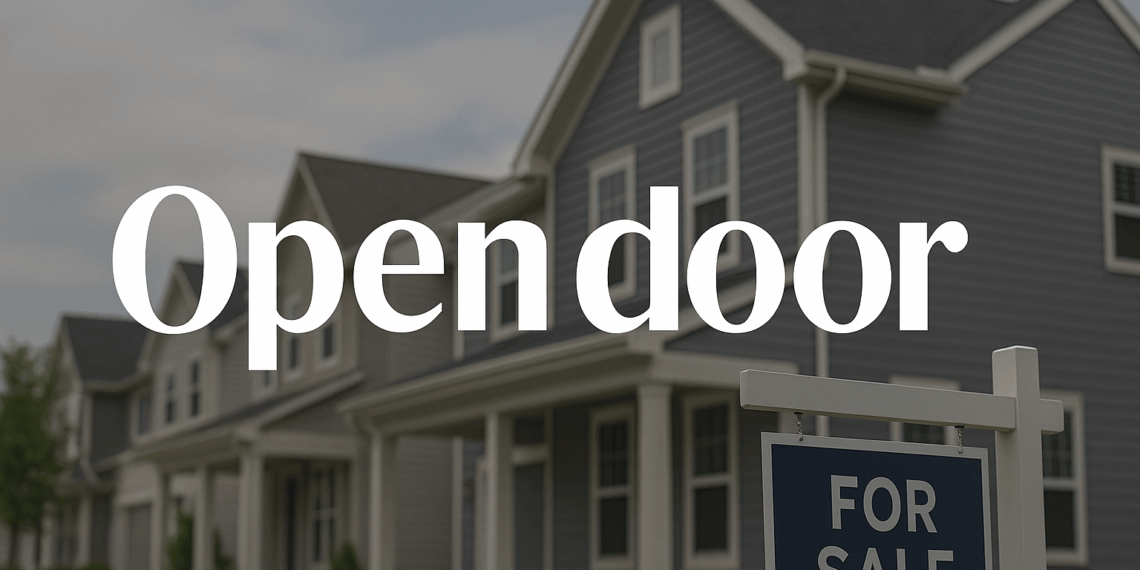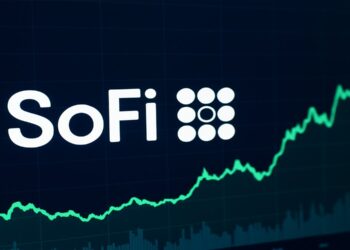The Opendoor stock (NASDAQ: OPEN) has staged one of the most remarkable comebacks of 2025. Once dismissed as another fading SPAC relic, the digital real-estate platform has surged back into focus — driven by renewed retail enthusiasm, leadership changes, and speculation that the iBuying pioneer might finally be turning a corner.
After trading near $0.50 earlier this year, the share price has skyrocketed more than 400 % year-to-date, briefly touching double-digit levels in mid-September before cooling slightly in October. Now, with a new management team and billions in market value regained, investors are asking: is Opendoor’s turnaround real, or just another meme-stock mirage?
Updated Market Snapshot – October 7 2025
As of the latest session on October 7 (19:13 CEST / 17:13 UTC), the Opendoor stock trades at $8.83, down 4.85 % on the day.
- Day range: $8.42 – $9.43
- Opening price: $9.26
- Volume: ≈ 125 million shares traded
- 52-week range: $0.51 (26 Jun 2025) – $10.87 (17 Sep 2025)
- Market capitalization: ≈ $6.0 – $6.8 billion
- 52-week change: +418 %
These figures highlight how intensely speculative OPEN remains — daily price swings above 5 % have become routine, and even modest headlines can trigger dramatic moves.
From Housing Tech Hope to Meme Stock Sensation
Opendoor was founded on a bold promise: to modernize real-estate transactions through iBuying — using data and algorithms to buy, renovate, and resell homes faster and more efficiently than traditional brokers.
It worked spectacularly well during the 2020-2021 housing boom. But when interest rates surged and housing activity froze, Opendoor’s model — capital-intensive and cyclical — nearly collapsed. Losses mounted, funding costs spiked, and the stock cratered by more than 90 %.
Fast-forward to 2025: Opendoor is once again in the spotlight. Retail investors have rediscovered the stock, major leadership changes have reignited optimism, and hopes of a broader housing recovery have helped propel prices back toward pre-crash levels.
Leadership Shakeup Sparks Renewed Optimism
A central catalyst behind Opendoor’s comeback was a leadership overhaul.
Former Shopify executive Kaz Nejatian stepped in as CEO, while company co-founders Keith Rabois and Eric Wu returned to the board — with Rabois assuming the role of chairman.
This symbolic reunion of Opendoor’s founding team has been interpreted as a message to both Wall Street and Main Street: the company intends to reclaim its startup spirit while enforcing tighter financial discipline.
For many retail traders, Rabois’ return carries near-mythic weight. Once part of PayPal’s early executive circle, he embodies Silicon Valley credibility — and his involvement has fueled the narrative that Opendoor might once again be an innovator rather than a cautionary tale.
Why Investors Are Paying Attention Again
Despite its troubled past, several powerful narratives have converged to lift Opendoor stock back into relevance:
- Retail Trading & Meme Momentum
The so-called “Open Army” — a growing online community of retail traders — has turned Opendoor into a meme phenomenon. Trading activity on Reddit and X (Twitter) often mirrors price spikes, amplifying volatility. - Improving Macro Outlook
Investors are betting on a gradual cooling of inflation and a potential Fed rate-cut cycle in 2026. Lower mortgage rates could revitalize housing demand, directly benefiting Opendoor’s transaction volume. - Leadership Confidence & Cost Discipline
Under Nejatian, Opendoor has trimmed expenses, optimized regional operations, and sought leaner inventory management — steps applauded by analysts looking for operational clarity. - Debt Restructuring & Liquidity Preservation
The company recently refinanced convertible notes and extended maturities, easing short-term pressure while maintaining liquidity near $1 billion. - Asymmetric Risk-Reward Profile
Trading under $10 but backed by billions in revenue, some see OPEN as a “high-beta housing play” — volatile, but with potential to multiply if profitability materializes.
The Harsh Reality: Structural Challenges Remain
Still, beneath the excitement lie unresolved fundamentals:
- Persistent Losses – Despite $10–12 billion in annual revenue, Opendoor remains unprofitable. Its margins are razor-thin, and quarterly losses continue to weigh on investor confidence.
- High Capital Requirements – The iBuying model ties up vast capital in housing inventory, exposing the company to price swings and financing risk.
- Extreme Volatility – With short interest still elevated, single-day moves of 10–20 % remain common.
- Insider & Institutional Selling – Periodic stake reductions by early investors have triggered mini sell-offs.
- Fragile Market Dependency – A slowdown in housing turnover or renewed rate hikes could quickly reverse gains.
In essence, Opendoor stock behaves more like an option on the U.S. housing cycle than a traditional equity investment.
Can iBuying Finally Work?
Opendoor’s thesis hasn’t changed: digitize real-estate transactions and make them as seamless as buying a car online.
The company believes that improvements in AI-driven pricing models, risk assessment, and automation can turn what was once a low-margin business into a scalable, profitable one.
However, execution risk remains enormous. Zillow famously abandoned iBuying after billions in losses, proving that data alone doesn’t immunize against housing volatility.
For Opendoor, survival depends on achieving faster inventory turnover and smarter regional focus — essentially flipping homes with algorithmic precision.
Financial Overview – 2025 Snapshot
| Metric | 2025 Estimate | Trend |
|---|---|---|
| Revenue | $10 – 12 billion | Stable / slightly lower YoY |
| Gross Margin | 2 – 4 % | Improving marginally |
| Operating Loss | > $300 million annually | Narrowing |
| Cash on Hand | ≈ $1 billion | Sufficient liquidity |
| Total Debt | ≈ $3 – 4 billion (incl. convertibles) | Refinanced & extended |
While liquidity is adequate, profitability remains distant. Even small housing-price fluctuations can erase quarterly gains.
Market Scenarios for 2025 – 2026
Bull Case (> $12 target)
The housing market rebounds, inventory turnover accelerates, and new leadership delivers operational efficiency. Opendoor achieves its first profitable quarter by late 2026. Retail and institutional confidence return.
Base Case ($6 – $10 range)
Momentum stabilizes; the stock trades in a volatile band. Meme activity and macro speculation continue to drive volume, but sustained profitability remains out of reach.
Bear Case (< $3 downside)
Mortgage rates rise again, liquidity tightens, and losses widen. Capital raises dilute shareholders; retail interest fades. OPEN re-tests 2024 lows.
Investor Strategy & Risk Management
- Position Sizing: Treat OPEN as a speculative asset — allocate only capital you can afford to lose.
- Time Horizon: Short-term traders can exploit volatility; long-term investors should demand tangible profitability progress.
- Key Metrics to Watch: Gross-margin expansion, inventory days, and debt servicing costs.
- Technical Levels: Support ~ $7.50 / Resistance ~ $10.50 — confirmed breakouts could trigger algorithmic buying.
Cautious accumulation during pullbacks, combined with strict stop-losses, remains the most prudent approach.
Broader Context: From SPAC Bust to Second Chance
Opendoor’s story mirrors the post-SPAC cycle itself — from exuberant 2021 valuations to brutal 2023 reality checks. Yet, few companies from that era have managed to regain market attention as effectively as Opendoor.
The company’s willingness to restructure, pivot, and re-embrace its original vision is earning tentative respect on Wall Street.
Whether this represents a sustainable turnaround or simply a well-timed speculative wave depends entirely on the next 12–18 months of execution.
Conclusion: High Risk, High Potential
The resurgence of Opendoor stock encapsulates both sides of modern investing — the emotional energy of retail traders and the cold logic of fundamental risk.
Yes, the company has stabilized operations and improved its narrative. But the core challenges of iBuying — capital intensity, cyclical exposure, and thin margins — still loom large.
At around $8–9 per share, OPEN offers volatility, liquidity, and a speculative entry point into a potential housing-tech rebound. For disciplined traders, that’s opportunity. For cautious investors, it’s a watch-list candidate at best.
FAQ – Opendoor Stock
Why is Opendoor stock moving so wildly?
Retail speculation, leadership changes, and shifting sentiment around housing drive rapid price swings.
Is Opendoor profitable yet?
No. Despite operational progress, the company still reports quarterly losses.
What could drive the next leg higher?
A housing rebound, positive cash flow, or surprise quarterly profit would be major catalysts.
Is the stock overvalued now?
At $8–9, valuations bake in optimism but not profitability; it’s neither cheap nor secure.
Should I buy Opendoor stock?
Only if you’re comfortable with high risk and potential short-term volatility. Long-term success depends on proven profitability.
Disclaimer
This article is for informational and educational purposes only and does not constitute financial advice or investment recommendations.
All opinions reflect the author’s judgment at publication time. Investing in equities such as Opendoor stock involves substantial risk, including the potential loss of all invested capital.







